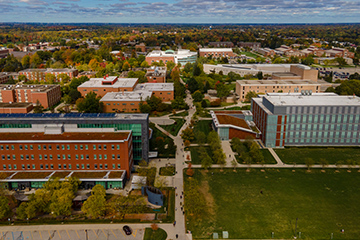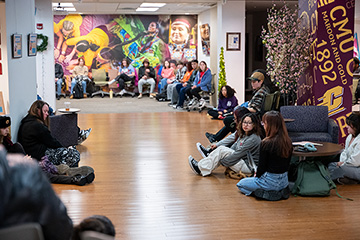Is sickle cell disease linked to falls?
CMU researcher says the inner ear can provide answers
The road to answering whether people with sickle cell disease fall more frequently leads to the inner ear, according to a Central Michigan University researcher.
Sickle cell disease is an umbrella term to describe a range of inherited blood disorders that cause red blood cells to bend into the shape of a sickle blade. These cells are hard, sticky and die early. They also can clog small blood vessels. That can lead to a range of complications.
One of them is hearing loss, said Dawn Nelson, a faculty member in the Department of Communication Sciences and Disorders. The parts of the inner ear related to hearing share structures, fluid and blood vessels with the those that control balance.
That raised the question of whether there was a connection between sickle cell-related hearing loss and dizziness. It was a question Nelson raised at a sickle cell disease conference.
She remembered asking the attendees, “How many of you have hearing loss?” More than half raised their hands. She followed up with, “How many of you have dizziness?” Again, more than half raised their hands.
Nelson started gathering data a couple of years later through a self-assessment survey. The survey asked about dizziness and falling. Responses pointed to an increased rate of both among people with sickle cell disease.
The self-assessment surveys only sought to connect sickle cell disease to increased rates of dizziness and falling, not explain why. Nelson said she wants to know if sickle cell disease damages the inner ear.
There are several ways it could, including depriving its centers of hearing and balance of blood. A blockage of just seconds can cause permanent damage, she said.
On the other hand, many respondents also said they also experienced numb feet, she said. That could provide a partial explanation.
What the surveys told her was enough to take the next step, collecting clinical data. Nelson has partnered with researchers at Johns Hopkins and the University of Michigan to gather data from people seeking treatment for the symptoms of sickle cell disease.
In addition to asking self-assessment questions, they are testing patients to see if they can connect their sickle cell disease to damage in the ear, she said. It’s not a certain proposition because some of the components are microscopic.
It’s likely to take several years to establish a firm link between increased falls by people with sickle cell disease and damage to the ear, she said. There is one place where Nelson said her research can yield immediate benefit. It can help attack stigma associated with sickle cell disease.
One of the things they discovered from the self-assessment surveys is that a good many respondents were educated, earned comfortable salaries, and had health insurance but didn’t seek medical care for their sickle cell disease.
Sickle cell disease occurs predominantly in people of color, Nelson said. Most people who inherit it currently live in Africa, although there are substantial numbers of people with it who live in the Middle East and parts of the Mediterranean Basin.
There is a stigma to it that Nelson said she’d like to see degraded.
One piece of reducing sickle cell stigma was publishing the results of her research in a way that made it publicly available. Nelson said she did that with critical support from CMU’s Office of Research and Graduate Studies.




